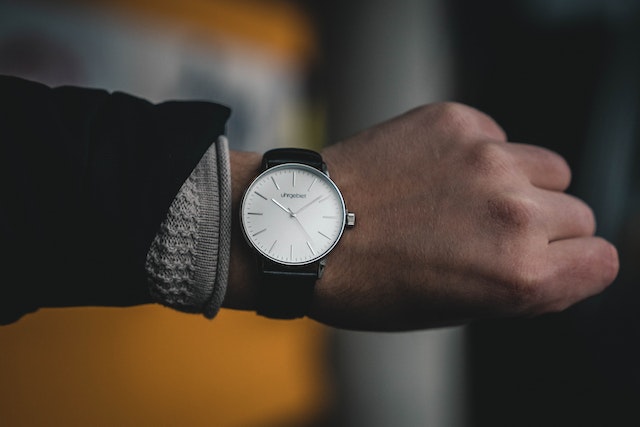
When did people start wearing wristwatches? People started wearing wristwatches during World War 1.
Clocks had been around for some time before the first watches appeared in the 15th century, in Europe. Several advancements were necessary before clocks could be made small enough to be a watch. Clocks generally worked by using a system of weights or a pendulum to make the mechanism turn. You obviously can’t put a pendulum on a watch. The mainspring was invented in the 15th century. This was a piece of coiled metal that tightened when the clock or watch was wound, storing the energy, and then slowly releasing the energy as it unwound, moving the mechanism. This was a huge jump forward in timepieces, but it wasn’t very accurate and the clock would slow down as the spring unwound, sometimes losing hours. In 1657, the balance spring and balance wheel were invented. These control how fast the mechanism in the clock or watch moves and make it far more accurate.
The first watches were worn on a chain around the neck and they were probably closer in size to clocks than to watches. They only had an hour hand and had no front. Over the next hundred years, they improved and grew smaller. Glass was fitted and the pocket watch was invented. Women often wore their watches on a jeweled bracelet on their wrist, but men wore their watch on a chain and kept it in a pocket. Clothing was even styled to suit the pocket watch. Waistcoats (vests) were introduced by King Charles II in about 1666. They were soon made with a small pocket to hold a pocket watch and a button to fasten the chain to. The pocket watch pocket can still be found on any pair of jeans. Some people tried to introduce a watch worn on the wrist, but men considered a watch worn on the wrist to be too small to be accurate, at risk of damage, and feminine. A pocket watch was reliable and a sign of masculinity.
It’s worth mentioning that most people didn’t need to know the time. To the average person working on the land or in a shop, there was no reason to need to know that it was 10:42 in the morning. You started work when it was light and stopped when it was dark. It was only really the introduction of shift work after the Industrial Revolution that created the need for people to know the time. Then the invention of trains and the train timetable furthered that need.
After the Industrial Revolution, the number of watches was increasing, but men still wore pocket watches and women wore smaller watches. As with many things, it took war to shake things up. The Second Boer war in Africa, between 1899 and 1902, was the first time watches were used in a battle. Timekeeping is vital during a military campaign. If two platoons have agreed to circle round an enemy and attack at the same time, they need to know when that same time is. There were no radio communications at the end of the 19th century, so the only way was to signal the other platoon was with flags or flares, both of which would ruin your element of surprise. Watches had become accurate enough that they could be relied upon to solve this problem. However, a soldier on a horse (watches were still expensive, so only the officers had them) with the reins in one hand and a gun in the other, would have a lot of trouble pulling a pocket watch out to see what the time was. Many officers commissioned a leather strap that could hold a pocket watch to the wrist. This did the trick, but a pocket watch is bulky and doesn’t sit well on the wrist. Smaller watches were manufactured in the hope that they would sell, but they never took off. Men still associated wristwatches with women and reverted to pocket watches when they were not fighting a war.
The First World War changed all of that. It became obvious that regular soldiers needed to know the time as well as their officers. There were rolling artillery barrages, where a wall of artillery was fired at a certain time. The troops had to advance towards the enemy behind this barrage at a certain pace, so knowing the time was a matter of life or death. The war was too large scale for everything to be controlled, so large groups of people had to be relied upon to attack at the same time. That called for them to know the time. Pocket watches were too expensive for regular soldiers, and they were too big for trench warfare, so wristwatches became common. So many millions of men wore wristwatches in the trenches that when they came back to civilian life, the wristwatch was second nature. Watch companies jumped on the bandwagon and started manufacturing cheap watches.
So many people wore them for so long that when the war ended, they had become a regular item, and all but completely replaced the pocket watch.
So, it took World War One for men to stop seeing wristwatches as feminine and for them to become commonplace. And this is what I learned today.
Sources
https://en.wikipedia.org/wiki/History_of_watches
https://www.nytimes.com/2013/10/23/fashion/wrist-watches-from-battlefield-to-fashion-accessory.html
https://www.theatlantic.com/international/archive/2015/05/history-wristwatch-apple-watch/391424/
https://en.wikipedia.org/wiki/Mainspring
https://en.wikipedia.org/wiki/Pocket_watch
https://en.wikipedia.org/wiki/Balance_wheel
https://initium.swiss/en/blog/how-a-manual-watch-movement-works
